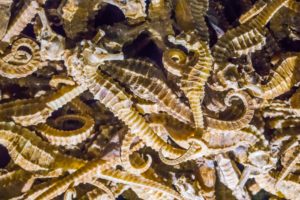Seahorses. Who doesn’t like these little guys? Spotting one among the coral is sure to bring a smile to any diver’s face. With their curved tails, round bellies and long snouts, it is easy to feel like you just want to put them in your pocket. Sadly, many species are either endangered or nearly extinct for that exact reason.
The International Union for Conservation of Nature’s Red List features 34 seahorse species. This means that they are either endangered or that scientists don’t have enough data to confirm that they are not endangered. The populations most in trouble are in Asia. But the problem is spreading globally as fishermen are looking for new seahorse hunting grounds.
Where have all the seahorses gone?
There are three markets that encourage mass capture and trade of seahorses. They often end up as by-catch of fishing and trawling practices. But these species are so valuable now that fishermen pick them from the by-catch to sell to one of the following markets.
Chinese medicine

Traditional Chinese medicine sees vast numbers of seahorses traded every year. Upwards of 150 million, animals, combined with the curio trade, die each year for this practice. Between 65 and 85 countries trade these animals for medicinal use, with more joining the list each year.
Traditional Chinese medicine purports that consuming seahorses can cure a variety of ailments, including asthma, throat infections, insomnia and abdominal pain. Consumers seek pregnant males especially as they believe the carcass can cure impotence. As consumers of medicines containing seahorses become wealthier, the demand has changed from purchasing them to prepare at home to the commercial production of pills containing seahorses. This means that fishermen now catch these animals commercially to produce mass quantities of the “medicine.”
About 90 percent of the captured and killed male seahorses are pregnant, leaving them no chance to reproduce and sustain populations.
After capture, fishermen hang the live animals in the sun to die and then dry. Once they are dried the fisherman sells them to a middleman, who then sells them to markets or factories that will process them to make medicine.
Home-aquarium trade
Trade for wild seahorses to the home-aquarium market reaches around one million each year. Only a small number of these animals survive longer than a few weeks. Seahorses require optimal water conditions to survive, which is not always possible to maintain in home aquariums. Education and breeding seahorses in captivity has created a culture of “conservation through cultivation,” with limited success.
The curio trade
Many shops, especially in touristy coastal towns, sell seahorses as mementos. This market also sees northward of one million seahorses traded every year. Although these products often feature a “sustainable,” label this is seldom — if ever — true. These creatures undergo the same fishing and drying practices as the ones selected for the Chinese medicine trade.
CITES and seahorses
The Convention on International Trade in Endangered Species of wild fauna and flora (CITES) is an agreement between most countries to regulate the trade in animals and plants to ensure that the it does not affect wild populations. Seahorses joined the list of protected species in 2004 due to the unsustainable practices in catching them.
Seahorses are on Appendix II of CITES, which covers species that are not necessarily near extinction yet but could face that fate if we fail to regulate trade properly. As per the Seahorse Trust, seahorses could become extinct in as little as 20 to 30 years if we do not curb trade or introduce more sustainable practices.
Because seahorses appear on Appendix II, they are subject to certain regulations including restrictions in their trade unless they are accompanied by a CITES permit. Absolutely all trade in seahorses requires CITES permits and authorization from a scientific or management authority. This includes export, import, re-export and re-import of any and all animals whether they are alive or dead, whole or in part.
What can we do?
Several organizations are trying to farm seahorses. They have not been fully successful but could eventually lower the volume of wild seahorses facing capture for trade.
Seahorses are fascinating creatures. Although they charm and entice, it’s best to leave them in the wild instead of an aquarium or as victims of the Chinese medicine or curio trade. Do not buy them if you see them in the market. If you see them, tell the store owner you won’t purchase anything in their establishment as long as they continue to trade in seahorses.

